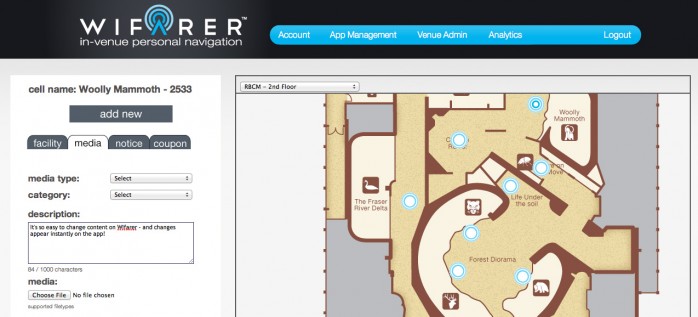
In conjunction with its public debut, Wifarer also announced that its software is fully implemented in the Royal BC Museum in Canada and in a pilot phase at Prudential shopping center in Boston. Partnerships with international airports, universities, and stadiums are currently in the pipeline.
[aditude-amp id="flyingcarpet" targeting='{"env":"staging","page_type":"article","post_id":500946,"post_type":"story","post_chan":"none","tags":null,"ai":false,"category":"none","all_categories":"business,mobile,","session":"B"}']The technology functions similarly to a GPS. It uses Wi-Fi signals to pinpoint a visitor’s location within a building and provides step-by-step navigational guidance. By opening the app, users have access to a full map of the building’s interior.
“Indoors isn’t the same as outdoors,” said CEO Philip Stanger. “Outdoors no one owns. You can map and monetize it as you want. Indoors is a different question because there are private concerns. Institutions and companies have put a lot of investment in building up value within these spaces, and are loathe to hand over mapping to someone else.”
AI Weekly
The must-read newsletter for AI and Big Data industry written by Khari Johnson, Kyle Wiggers, and Seth Colaner.
Included with VentureBeat Insider and VentureBeat VIP memberships.
This is one of the reasons a scrappy startup like Wifarer could distinguish itself from mammoth companies like Google, Microsoft, and Apple that also offer mapping technology. It strives to make its presence as transparent as possible and cedes control over to the venues to incorporate media and “branding assets” as they choose. The organizations can then use it as a tool to carry out their own goals without having to jump through corporate or proprietary hoops.
There are a plethora of use cases for the app. It could entail flight displays and departure information in an airport, or notifications about ongoing sales in a mall. Stanger gave the example of a trip to a science museum. A visitor can orient within the museum, get directions to the Woolly Mammoth display, and then receive curated information about the Woolly Mammoth while standing in front of it.
People can create their own, personalized tours based on their interests rather than wandering haphazardly around the exhibits. Those with a paralyzing fear of mummies can avoid the Ancient Egypt section, and it is a piece of cake to zero in on the source of a mouthwatering baking scent wafting through a mall (two puns, one sentence).
Wifarer is free for users to download and can transition smoothly from spot to spot. For example, if the science museum is near a shopping center, the app will shift to reflect a change in the user’s location, displaying new maps and site specific content.
The technology is complicated and has taken over two years to develop. It uses the signal from smart devices and Wi-Fi access points to provide real-time positioning, eliminating the need for expensive hardware. Venues pay an annual licensing fee for the software-as-a-service and from there, have control over how it is used.
The company currently has 15 employees with offices in Victoria, British Columbia and San Jose, Calif. It has bootstrapped up until now, and plans to begin fundraising in the fall.
[aditude-amp id="medium1" targeting='{"env":"staging","page_type":"article","post_id":500946,"post_type":"story","post_chan":"none","tags":null,"ai":false,"category":"none","all_categories":"business,mobile,","session":"B"}']
VentureBeat's mission is to be a digital town square for technical decision-makers to gain knowledge about transformative enterprise technology and transact. Learn More
